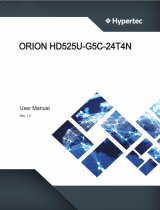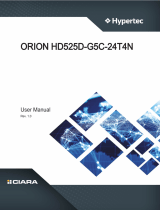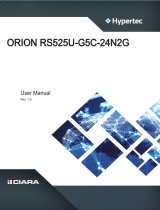
- 3 -
Table of Contents
MZ31-AR0 Motherboard Layout ......................................................................................5
Block Diagram .................................................................................................................7
Chapter 1 Hardware Installation .....................................................................................9
1-1 Installation Precautions .................................................................................... 9
1-2 ProductSpecications .................................................................................... 10
1-3 Installing and Removing the CPU and Heat Sink ........................................... 12
1-4 Installing and Removing Memory ................................................................... 13
1-4-1 8-ChannelMemoryConguration ..........................................................................13
1-4-2 Installing and Removing a Memory Module ..........................................................14
1-4-3 Processor and Memory Module Matrix Table .........................................................14
1-4-4 Memory Population Table ......................................................................................15
1-5 Installing and Removing the M.2 SSD Module ............................................... 16
1-6 Back Panel Connectors .................................................................................. 17
1-7 Internal Connectors ........................................................................................ 19
1-8 Jumper Settings ............................................................................................. 27
Chapter 2 BIOS Setup ..................................................................................................28
2-1 The Main Menu .............................................................................................. 30
2-2 Advanced Menu ............................................................................................. 33
2-2-1 Trusted Computing .................................................................................................34
2-2-2 PSP Firmware Versions ..........................................................................................35
2-2-3 Legacy Video Select ...............................................................................................36
2-2-4 AST2500SuperIOConguration ...........................................................................37
2-2-5 S5 RTC Wake Settings ...........................................................................................40
2-2-6 Serial Port Console Redirection .............................................................................41
2-2-7 CPUConguration ..................................................................................................45
2-2-8 PCI Subsystem Settings .........................................................................................46
2-2-9 USBConguration ..................................................................................................48
2-2-10 NetworkStackConguration ..................................................................................50
2-2-11 NVMeConguration ...............................................................................................51
2-2-12 SATAConguration.................................................................................................52
2-2-13 GraphicOutputConguration .................................................................................53
2-2-14 AMDMemCongurationStatus .............................................................................54
2-2-15 TlsAuthConguration ............................................................................................55
2-2-16 iSCSIConguration ................................................................................................56
2-2-17 QLogic 577xx/578xx 10 Gb Ethernet BCM57810 ...................................................57
2-2-18 VLANConguration ................................................................................................68






















